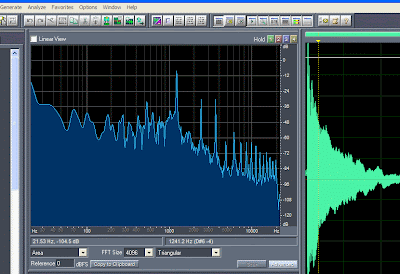This is a work in progress…
Adding some complexity, but this will diminish later.
This is the last version for now, I think. I slow the piece down by a small amount every 40 seconds until it is running around 11% slower at the end. Each of the 12 tempo reductions are done by the ratio of 2^(1/72), which is the 72nd root of two (1.0096735332). The beats per minute are divided by that number 12 times. Coincidentally, that’s the same as the ratio of one note to the next in 72-EDO, the tuning the piece is realized in. I can’t figure out how that happened, but there it is.
Csound takes care of tempo with the t tempo statement.
t0 1200 800 1200 896 1188 1592 1188 1688 1176 2376 1176 2472 1164 3152 1164 3248 1152 3920 1152 4016 1140 4680 1140 4776 1129 5432 1129 5528
1118 6177 1118 6273 1107 6915 1107 7011 1096 7645 1096 7741 1085 8368 1085 8464 1074 9084 1074 9180 1063 9792 1063 9888 1052 10493 1052 10589
The t0 makes it a tempo statement. The next number is the beats per minute, in this case 1200. A quarter note is about 8 beats when there are 1200 beats a minute. The next number after beats per minute is the number of beats where the next tempo marker is found, in this case 1200. So it stays at 1200 beats a minute for 800 beats, about 100 eighth notes. The next number 896 is the beat marker, and 1188 is the beats per minute. 1200 / 1.0096735332 is 1188, approximately. Over the next 96 beats or 12 eighth notes, it slows down from 1200 to 1188 beats per minute. Then at beat 1592 it starts to slow down to 1176 beats per minute, arriving at that speed at beat 1688. The overall effect is a gradual slowing down, sometimes noticably, sometimes imperceptively, until it stops.
This is another take on the same piece I’ve been working on for a while. This version includes adjustments to the tuning of the samples. There were some intonation problems with the marimba, harp, vibes, flute, and balloon drum. To determine pitch I used Cooledit (now called Adobe Audition) and its FFT option. You basically load a sample file and select Analyze-FFT and it puts up a Fast Fourier Transfer window showing the most prominent frequencies, with the pitch in note/cents from 12-EDO for the most prominent frequency. For most non-bass notes that is the fundamental. Here’s one for the harp D#6, 4 cents flat at a point about half a second into the harp sample. 
My Csound preprocessor allows me to put -4 into a list of samples, and Csound adjusts the sample when it’s used in the synthesis instrument. Four cents is not noticiable, for the most part. Anything over 10 is not good.
Most of these samples, from the McGill University Master Samples CDROM library, are not very in tune, and they don’t necessarily hold the same pitch for the whole note. Many go up and down by a few cents from the start to finish.
This is the first time I have systematically used the Cooledit frequency analysis to fine tune the samples. I previously tuned them by ear to a reference sine wave. It was a time consuming process, and error prone. The harp sample was particularly out tune, with one note 43 cents off, and others 10-20 off. The flute was also way out of tune, with the highest note 31 cents sharp. Here’s C6 31 cents sharp one second into the sample. Typical flute player getting excited that he can hit such a high note. I back that sample down by 31 cents and we are good to go.
This is a version of the finished work. It is scored for flutes, marimba, vibe, finger piano, harp, balloon drums, and a percussion board with a contact microphone. The latter instrument includes several rocks, toothbrushes, and pieces of wood, glass, and rocks glued to the surface of a piece of sitka spruce. If you hear something that sounds like a monkey chant, it’s probably the percussion board.
The intonation is 72-equal divisions of the octave (72-EDO) approximating the Partch tonality diamond to the 15 limit. There are many glissandi and trills employed. The marimba and vibe are given many opportunities to trill and slide around their pitches. The triad is the basic melodic element, either 4:5:6 or 7:9:11 or their inversions in the major scale, and comparable chords in the sub-minor and minor modes.
The piece starts out in B 16/9, with a scale based on the overtone series. As shown on the chart below, it modulates around the tonality diamond from there. Click on the chart for a larger version. The yellow colored blocks are the B 16/9 major scale. The subminor D 12/11 is in orange, the subminor G 3/2 is in pink, the C 1/1 minor is green, and the F 4/3 major is in blue. I use glissandi to slide from one chord to another.
As with all my works, there is a great deal of indeterminacy. Each instrument has many choices to make, subject to constraints about repeatability and change. Imagine a band improvising from a set of approved riffs.
This is a work in progress…
The bridge has the changes referred to earlier.